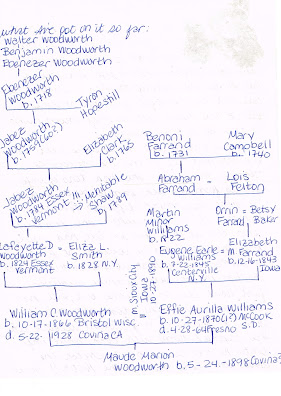It was a "giving back" project which started me on a path of finding "orphan" photos and putting family history research skills to work to return them to long-lost family. Genealogists have long had a tradition of volunteering to help other researchers—especially those just starting out—because we, too, were once beginners. We call it "giving back" in gratitude for what others once did to help us, or "paying it forward," knowing that one day, we too will need a hand with our brick wall research problems.
Never did I think, however, that one day I'd find myself rescuing my own family's pictures, but that is exactly what happened when I got the message that someone had found Marilyn Sowle Bean's photo collection in a local antique store.
Finding Marilyn's photos prompted me to dive deeper into a project which I had started but long ago set aside: to find any sign in her now-deceased son's family tree of the genetic origin of the disease which eventually cost him his life. I already knew there were several cousins in the family related to Marilyn's mother-in-law, Maude Woodworth Bean, who had inherited some form of Marfan Syndrome, but that there weren't any signs of the malady in the other branches of the family.
In this past month—after a research lull following my inability to find details on the month's goal for my Twelve Most Wanted ancestors—we spent the month exploring the family related to Marilyn's mother-in-law, Maude. We made it through each of Maude's four grandparents' lines—Woodworth, Williams, Farrend, and Smith—but I can't say that I located any conclusive evidence to pinpoint that deadly heritage upon any of those four lines.
Granted, seeking early deaths in a family timeline stretching back into the nineteenth century can be a tricky business. Recorded causes of death are not as accessible in those old files as they might be in a modern death certificate. Besides, given that Marfan Syndrome wasn't observed as a separate entity until it was first described by a pediatrician—by the name of Antoine Marfan, as you may have guessed—in 1896, or even used as a descriptor of that set of symptoms until 1931, there would be no mechanism for pinpointing such a cause of death in Maude's ancestors of the 1800s.
But, of course, we could still guess. Any male descendant in Maude's grandparents' lines who died as a young adult caught my eye. However, many early deaths could be ruled out by the usual explanations of that century: injuries from battle in wars, contagion from widespread diseases among them.
But there were others whose demise still left me puzzled—such as Joel Smith, the twenty year old brother of Maude's paternal grandmother. His death in 1852 was noted only by a cenotaph erected where his parents lived in Kenosha County, Wisconsin. Looking closely at the monument, a now-barely legible line after his name and date of death states "Buried in Greenwood Cemetery NY." As you might have guessed, there is more than one cemetery in New York by that name, and no, none of them produces a record of that name when searched on Find A Grave—let alone any obituary published in a New York newspaper.
Along the way in this pursuit of Marfan Syndrome in Maude Woodworth Bean's family, we did make some worthwhile discoveries. I've built out a family tree for Marilyn—yes, her side was included in this effort—and ventured beyond just the names, places, and dates to discover the stories behind the statistics.
But there is a melancholy down side to all the discoveries: there is no one left in the family with whom to share these stories. They are all gone: Marilyn, her two children, her parents and in-laws, even those cousins whose telltale height trumpeted their inheritance of Marfan Syndrome.
On the bright side, I also learned that what once might have been a very elongated death knell—after all, we all have been handed a terminal diagnosis, it's just that some of us get down to the business of it quicker than others—may now be far from such a somber diagnosis. While still a serious consideration, Marfan Syndrome is apparently now one which has been said to allow for "something approaching a normal lifespan." That is a remarkable victory.
All told, I'll still keep working on Marilyn's family photographs. As for the research goal of pinpointing family in previous generations afflicted with Marfan Syndrome, I will keep building out Maude's family tree and learning her relatives' life stories.
But this is a new month, and with the flip of a calendar page comes yet another research goal to conquer. Though I've made the unfortunate choice of piggy-backing December's goal with that of my failed November goal, we'll still review what, if anything, can be found, before moving on to more discussion on "giving back" projects and, finally, wrapping up the month with a look ahead to the new year's Twelve Most Wanted.








